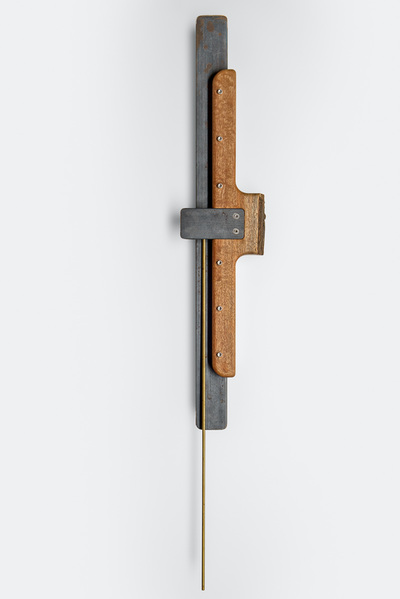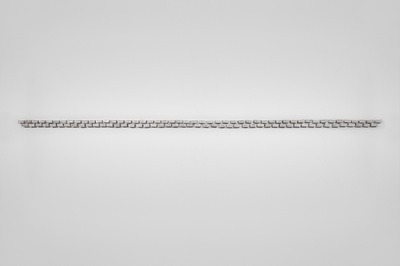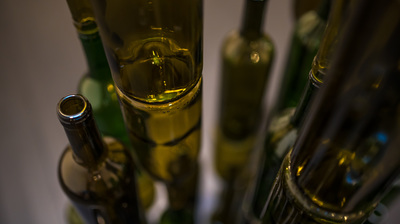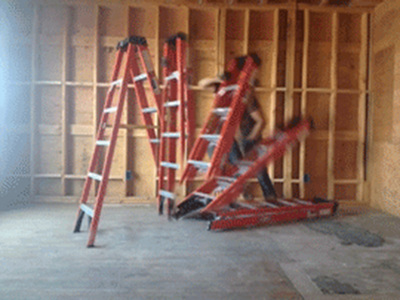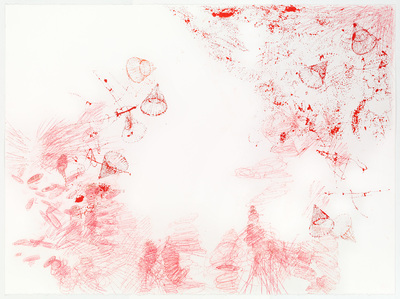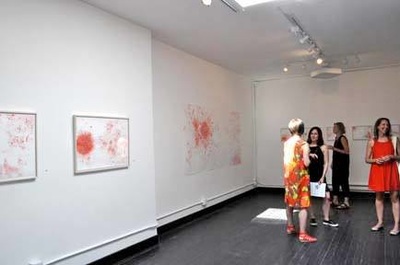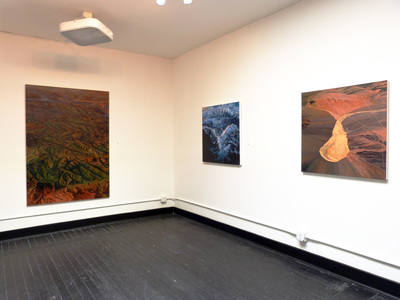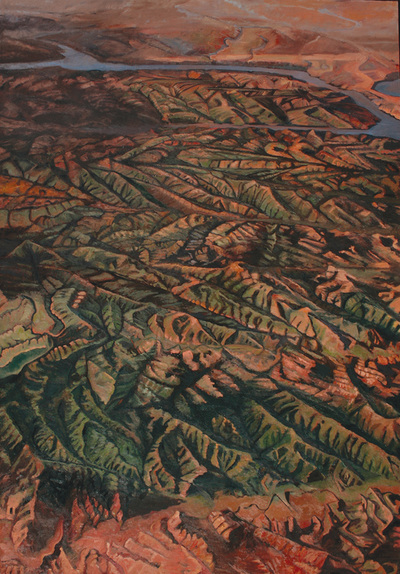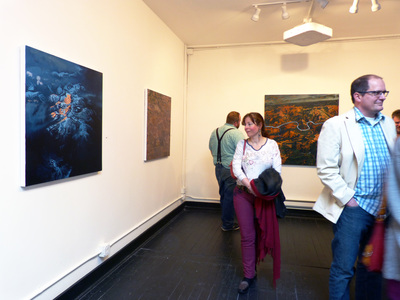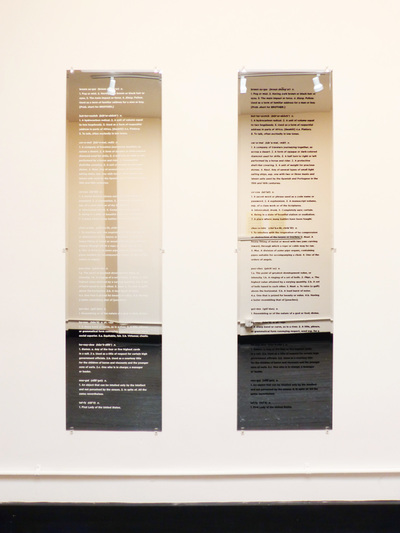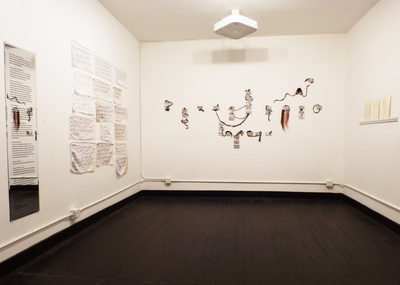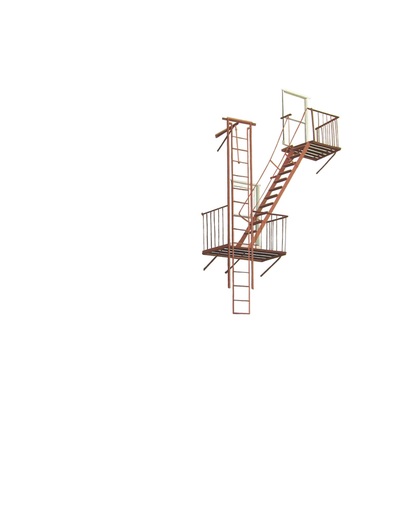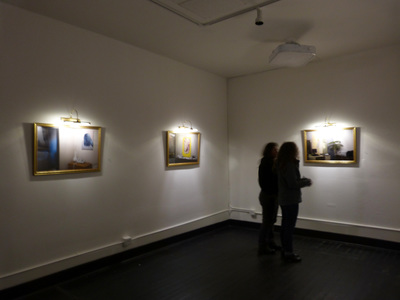2014 SHOWS
December \ Jared Bender \ Plumb, Level, & Square
 Jared Bender \ 3' Closed Level
Jared Bender \ 3' Closed Level
Jared Bender’s sculpture reflects both his practice in the studio, as well as his occupation as a builder and craftsman. For Plumb, Level, & Square he has made a series of free-standing and wall-based sculptures from repurposed castaways. Through the use of this process-based language he continues his exploration of the nature of manual labor and love of his medium. The hand of the artist is evident in the transformation from its raw organic shape into one that is integrated with something more sculpted, machined, or manipulated.
These objects resonate because we recognize the instruments and materials we see: a five foot long and 3 foot long plumb level made of wood, steel, and brass; two three foot long square levels made of wood and glass; a square of mahogany peg board, and a massive wooden I-beam. Three high-gloss t-shirts shellacked on the matte surface of the gallery wall represent the general uniform of a construction worker, with three “high viz” safety stripes in brass gleaming from the front of each one. These are the trappings, tools, and environs of a construction worker. The presentation is humbly understated. The result is streamline, sincere, and satisfying; like a job well done at the end of a long day. Bender deftly includes the contemporary and art historical references which also inspire him, such as Donald Judd and Seattle artist Dan Webb. The visual repetition throughout the show is a nod to Minimalism - as the 2004 Guggenheim exhibition so aptly phrased it, “singular forms, sometimes repeated”; the directive to create one object and repeat it for impact appears throughout Plumb, Level, & Square. Bender’s ode to Webb and medium-focused artists like him is demonstrated through his skill, devotion, and attention to detail.
These objects resonate because we recognize the instruments and materials we see: a five foot long and 3 foot long plumb level made of wood, steel, and brass; two three foot long square levels made of wood and glass; a square of mahogany peg board, and a massive wooden I-beam. Three high-gloss t-shirts shellacked on the matte surface of the gallery wall represent the general uniform of a construction worker, with three “high viz” safety stripes in brass gleaming from the front of each one. These are the trappings, tools, and environs of a construction worker. The presentation is humbly understated. The result is streamline, sincere, and satisfying; like a job well done at the end of a long day. Bender deftly includes the contemporary and art historical references which also inspire him, such as Donald Judd and Seattle artist Dan Webb. The visual repetition throughout the show is a nod to Minimalism - as the 2004 Guggenheim exhibition so aptly phrased it, “singular forms, sometimes repeated”; the directive to create one object and repeat it for impact appears throughout Plumb, Level, & Square. Bender’s ode to Webb and medium-focused artists like him is demonstrated through his skill, devotion, and attention to detail.
November \ Sean M. Johnson \ Before When

Seattle-based artist Sean M. Johnson returns to LxWxH with his second exhibition in the space. For this show, Before When, he will pursue a series of site-specific installations which investigate the idea of between-ness; such as the moment between hearing and comprehending, the space between information and reaction, or the time between emotion and acceptance. Employing balance, remnants, and limbo, Johnson continues to use objects as metaphor to the human spirit.
If art imitates life, my art is certainly sustained by a need to reinforce humanity. Not only do I endeavor to make work that reflects or refracts rich moments, I want my work to connect with the viewer on a level that reminds them of their own experience. If in my life I am able to help a stranger carry their heavy bags up a flight of stairs as an act of generosity, accordingly in my art I want to help a stranger remember the joy of playing with their favorite toy as a compassionate admonishment (we were all young and innocent once). In sharing my personal experience through my artwork I hope to remind the viewer of their own experience and ultimately form a new experience of synthesis. I am aware that my art is not intensely political or social, however I do believe it is intensely human because of this impetus.
-Sean M. Johnson
If art imitates life, my art is certainly sustained by a need to reinforce humanity. Not only do I endeavor to make work that reflects or refracts rich moments, I want my work to connect with the viewer on a level that reminds them of their own experience. If in my life I am able to help a stranger carry their heavy bags up a flight of stairs as an act of generosity, accordingly in my art I want to help a stranger remember the joy of playing with their favorite toy as a compassionate admonishment (we were all young and innocent once). In sharing my personal experience through my artwork I hope to remind the viewer of their own experience and ultimately form a new experience of synthesis. I am aware that my art is not intensely political or social, however I do believe it is intensely human because of this impetus.
-Sean M. Johnson
October \ LoveCityLove \ Four 1 week exhibitions curated by Jessa Carter

2014 has revealed itself to be a year of collaboration for LxWxH. In the interest of continuing our desire to create an inclusive and dynamic space, we have invited Love City Love to inhabit the gallery over the next month for exhibitions, talks, music, and performance. We truly admire LCL's ability to reach these goals and interests, and want to support their vital and engaging presence in Seattle by offering our space.
Love City Love will present a series of exhibitions, performances, and talks which explore the intersection of storytelling, music, art, and science at LxWxH in Georgetown during the month of October. WEDNESDAYS ON SATURDAYS is the enigmatic communal exploration of sound and movement hosted by musicians who have contributed to the improvisational experience since Love City Love established the first WEDNESDAY 2 years ago. Led by Amos Miller and Evan Flory Barnes, Love City Love musicians will explore the enigmatic practice of improvisational sound and movement. Any and all are invited to join in and share their music, song, poetry, dance, and rhythm.
All images below courtesy of Jessa Carter and LoveCityLove.
Love City Love will present a series of exhibitions, performances, and talks which explore the intersection of storytelling, music, art, and science at LxWxH in Georgetown during the month of October. WEDNESDAYS ON SATURDAYS is the enigmatic communal exploration of sound and movement hosted by musicians who have contributed to the improvisational experience since Love City Love established the first WEDNESDAY 2 years ago. Led by Amos Miller and Evan Flory Barnes, Love City Love musicians will explore the enigmatic practice of improvisational sound and movement. Any and all are invited to join in and share their music, song, poetry, dance, and rhythm.
All images below courtesy of Jessa Carter and LoveCityLove.
Loose Leaf is a multi-faceted show about accepting and rejecting the
traditional and formal methods of presenting and sharing information. And "information."
Starting with an opening night party on Friday October 17 and lasting through the weekend, "short fiction" (and very "short fiction") and "illustrations" by Laura Sullivan Cassidy are presented uncollected and unbound—and collected and bound, too.
Additionally, "visual work" and commentary from 16 minds including established galleried artists such as Whiting Tennis, Joey Veltkamp, Erin Frost, Sierra Stinson, Dylan Neuwirth, and Victoria Haven, emerging artists Lucien Pellegrin, Lindsay Apodaca, Ursula Rose, and Lana Sharp, as well as well-known designers, photographers and cinematographers like Jesse Brown, Avi Loud, Charlie Schuck, Kyle Johnson, Jacob Rosen, Erin Sullivan and Eleanor Petry, are presented in-process, un-baked, raw, and in seedling form.
All of these ideas are shown in the manner of work-in-progress "two-page spreads" as if in the pre-production work room of some publication. The viewing of this un-precious, un-framed, un-bound, un-published "information" replaces the process of printing, publishing, and distribution. The viewing, in some cases, replaces the process of reading. Loose Leaf is a show about new methods of storytelling. It is an opportunity to think about how, when, and why we open up the windows and share what we know. Or "know."
Loose Leaf is a Love City Love joint curated by Laura Sullivan Cassidy and Jessa Carter and staged at Sharon Arnold's LxWxH gallery in Georgetown. Please join us for DJ tunes, live performance, and merrymaking on 10/17 from 7 to 11. Drink specials at area bars are in the works; you are encouraged to BYOB as well.
traditional and formal methods of presenting and sharing information. And "information."
Starting with an opening night party on Friday October 17 and lasting through the weekend, "short fiction" (and very "short fiction") and "illustrations" by Laura Sullivan Cassidy are presented uncollected and unbound—and collected and bound, too.
Additionally, "visual work" and commentary from 16 minds including established galleried artists such as Whiting Tennis, Joey Veltkamp, Erin Frost, Sierra Stinson, Dylan Neuwirth, and Victoria Haven, emerging artists Lucien Pellegrin, Lindsay Apodaca, Ursula Rose, and Lana Sharp, as well as well-known designers, photographers and cinematographers like Jesse Brown, Avi Loud, Charlie Schuck, Kyle Johnson, Jacob Rosen, Erin Sullivan and Eleanor Petry, are presented in-process, un-baked, raw, and in seedling form.
All of these ideas are shown in the manner of work-in-progress "two-page spreads" as if in the pre-production work room of some publication. The viewing of this un-precious, un-framed, un-bound, un-published "information" replaces the process of printing, publishing, and distribution. The viewing, in some cases, replaces the process of reading. Loose Leaf is a show about new methods of storytelling. It is an opportunity to think about how, when, and why we open up the windows and share what we know. Or "know."
Loose Leaf is a Love City Love joint curated by Laura Sullivan Cassidy and Jessa Carter and staged at Sharon Arnold's LxWxH gallery in Georgetown. Please join us for DJ tunes, live performance, and merrymaking on 10/17 from 7 to 11. Drink specials at area bars are in the works; you are encouraged to BYOB as well.
September \ Max Kraushaar \ OHP:T
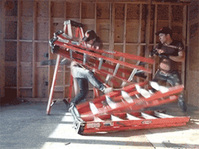 Max Kraushaar \ Sidekick
Max Kraushaar \ Sidekick
Seattle artist Max Kraushaar explores a study of ladders collapsing and being forcefully deconstructed through animated gifs.
Kraushaar is working through some personal stuff at work. As a contractor, most of his time is spent dealing with how things are put together and taken apart. The end result is dozens of movement pieces that last less than two seconds.
A collection of gifs made over a long period of time, OHP:T is a physical display of a large body of work that has so far only been available online. The pieces will be displayed on small tablet-sized screens throughout the gallery, to be viewed intimately. Introducing the first installment in a series that has stretched three years, Kraushaar invites you to confront your daily boredom and routine with self-education and physical exploration.
Kraushaar is working through some personal stuff at work. As a contractor, most of his time is spent dealing with how things are put together and taken apart. The end result is dozens of movement pieces that last less than two seconds.
A collection of gifs made over a long period of time, OHP:T is a physical display of a large body of work that has so far only been available online. The pieces will be displayed on small tablet-sized screens throughout the gallery, to be viewed intimately. Introducing the first installment in a series that has stretched three years, Kraushaar invites you to confront your daily boredom and routine with self-education and physical exploration.
July \ Cullom Gallery \ Ellen Ziegler Vermilion
 Ellen Ziegler \ Vermilion #7 detail
Ellen Ziegler \ Vermilion #7 detail
Vermilion, Ziegler’s newest series of drawings, brings to bear these early encounters in a visceral way that commands our interaction with both the eye and the imagination. As a gallerist, I am excited by work that evinces the human hand and its wondrous variety of expression. Seeing Ellen’s drawings for the first time, my impulse was to visually wander across each sheet from close range, linger in frenzied areas to untangle layers, marvel at the power contained in certain marks, consider implied associations to biology, astronomy, and maps, and delight in places where these aggressive and delicate declarations tapered to empty fields of white paper.
This series is about materials and Ziegler’s well-honed understanding of the particulars of each one. Like someone committing to muscle memory the complicated scales of jazz improvisation, Ziegler has spent years with her practice, which now allow her to riff across the page with confidence. Her preference for arcane and obsolete materials and tools also affects her work; innate variability plays out in ways unplanned, but welcomed in their final result.
For Vermilion, Ziegler has used transfer paper saturated with pigment, which she manipulates both for mark making and as an applied layer like chine-collé. As a tool she employs an obsolete piece of sign painter’s equipment which, when electrified, leaves burned pinhole trails. Other methods include stencils that she prick-burns, which respond with blot-like pointillist shapes when pigment is pounced through, and irregular scorched holes resulting from her momentary controlled burning of the drawing paper.
-Beth Cullom
This series is about materials and Ziegler’s well-honed understanding of the particulars of each one. Like someone committing to muscle memory the complicated scales of jazz improvisation, Ziegler has spent years with her practice, which now allow her to riff across the page with confidence. Her preference for arcane and obsolete materials and tools also affects her work; innate variability plays out in ways unplanned, but welcomed in their final result.
For Vermilion, Ziegler has used transfer paper saturated with pigment, which she manipulates both for mark making and as an applied layer like chine-collé. As a tool she employs an obsolete piece of sign painter’s equipment which, when electrified, leaves burned pinhole trails. Other methods include stencils that she prick-burns, which respond with blot-like pointillist shapes when pigment is pounced through, and irregular scorched holes resulting from her momentary controlled burning of the drawing paper.
-Beth Cullom
June \ Tim Cross \ Syzygy
 Tim Cross \ Searchers
Tim Cross \ Searchers
In this solo exhibition of new work in xerox and laser transfers, Tim Cross explores composition, alignment, and storytelling. While imagining the title "Syzygy", Cross initially thought of Carl Jung's union of opposites; the syzygy itself representing completion and wholeness. Cross' clever use of form, color, and texture maximizes the materials to their greatest potential, resulting in a rich and varied body of work. Cross' series describes a fantastic and colorful science fiction landscape: ambiguous ship-like objects fly across an unfamiliar sky, through chemical clouds and strange rock formations, transmitting signals into the unknown.
I make abstractions, which are open to interpretation. They are narrative landscapes which envision a dream that somewhere in the future, human culture will not be bound to the earth. Making maps, structures, ships, and stories satisfies my curiosity as I dream of a million years from now. The materials and methods I use are fairly simple: silk as a support, something from nature that acts both physically and symbolically to ground my ideas; and photocopied prints which are altered and transferred to the silk using matte medium. The textures and stresses in the making become part of this story of creation and decay. At times I see my work as rough and unwieldy, or something to be tamed. For now I will let these pieces sit like dreams, little windows that send my imagination out to where even light has yet to go.
-Tim Cross
I make abstractions, which are open to interpretation. They are narrative landscapes which envision a dream that somewhere in the future, human culture will not be bound to the earth. Making maps, structures, ships, and stories satisfies my curiosity as I dream of a million years from now. The materials and methods I use are fairly simple: silk as a support, something from nature that acts both physically and symbolically to ground my ideas; and photocopied prints which are altered and transferred to the silk using matte medium. The textures and stresses in the making become part of this story of creation and decay. At times I see my work as rough and unwieldy, or something to be tamed. For now I will let these pieces sit like dreams, little windows that send my imagination out to where even light has yet to go.
-Tim Cross
May \ Nancy Baker \ Come Hell or High Water
 Nancy Baker \ Cash is King
Nancy Baker \ Cash is King
Nancy Baker is a NYC artist focusing on painting and collage. In her solo show at LxWxH, Baker continues to investigate two-dimensional work mixing digital representations of hardware parts and abstracted forms. In Baker's work, chains, rivets, bolts and connectors transform otherwise stoic blue collar objects into transcendent images of floating worlds which are populated by numbers and letters against starry skies. Often citing literary sources, specific phrases wind their way through a labyrinth of connected phrases, jewels, glitter and paper machine fixtures; much like the tales she is referencing.
Baker’s work is about process, beauty, composition, and a few parts magic. Historically, she has remained close to the tradition of collage, working on a base of heavy paper to build up layers of pattern and color. Now she’s coming off the frame, abandoning the armature of the paper to create reinforced cutouts of lacy, intricate latticework. Their structures defy the laws of physics, and employ shadow as part of their composition. The collage itself has broken free to become sculptural installation requiring the company of others, forming clusters of growth along the span of a wall that throw out runners to propagate. Viewing this installation at LxWxH brings about a feeling of organic compositions of accumulated material to create a sense of environment and natural growth.
Baker’s work is about process, beauty, composition, and a few parts magic. Historically, she has remained close to the tradition of collage, working on a base of heavy paper to build up layers of pattern and color. Now she’s coming off the frame, abandoning the armature of the paper to create reinforced cutouts of lacy, intricate latticework. Their structures defy the laws of physics, and employ shadow as part of their composition. The collage itself has broken free to become sculptural installation requiring the company of others, forming clusters of growth along the span of a wall that throw out runners to propagate. Viewing this installation at LxWxH brings about a feeling of organic compositions of accumulated material to create a sense of environment and natural growth.
April \ Claire Johnson \ a•nas•to•mo•sis
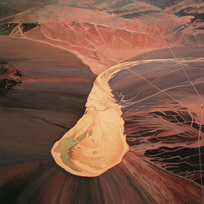 Claire Johnson \ Anastomosis (Nevada)
Claire Johnson \ Anastomosis (Nevada)
a•nas•to•mo•sis features a new series of aerial landscape paintings by Claire Johnson. Johnson explores contour, pattern, and color formed either by nature or human intervention across the earth's surface. In past work, she has explored themes heavily related to the blood of the human body. The connection to this past investigation is tied to these landscapes in the similarities between the branching systems of blood vessels, roads, and river-pathways; linking distant parts or places aren't obviously connected at first glance.
The earth as seen from above astonishes me. It is abstract and orderly at the same time. I am fascinated by the patterns and colors that natural forces create and the way human-made changes interact with each other. Together they weave intricate patterns branching out, flowing and connecting like the veins of a leaf or the blood vessels in our bodies. When I look at the earth below, I see a pattern that travels from macro to micro, from the draws and fissures of mountains, streams to rivers, roads to cities; the pattern repeats everywhere.
-Claire Johnson
Please click here to read the catalogue essay.
The earth as seen from above astonishes me. It is abstract and orderly at the same time. I am fascinated by the patterns and colors that natural forces create and the way human-made changes interact with each other. Together they weave intricate patterns branching out, flowing and connecting like the veins of a leaf or the blood vessels in our bodies. When I look at the earth below, I see a pattern that travels from macro to micro, from the draws and fissures of mountains, streams to rivers, roads to cities; the pattern repeats everywhere.
-Claire Johnson
Please click here to read the catalogue essay.
March \ stereotype \ curated by C. Davida Ingram

Artists: Barbara Earl Thomas, C. Davida Ingram, Duriel E. Harris, francine j. harris, Krista Franklin, Natasha Marin
If you've ever spent any time on the colorline you know it is infernal. But what do you see from hanging out there?
stereotype is an interdisciplinary project that features 6 national artists who enter the visual field of race by dint of text. The exhibition's title is a partial nod towards the word 'stereotype' having its first meaning as a plate used to press images. It is also a (quiet) suggestion that the written word might also exist as an image by other means.
The text-based pieces in stereotype focus on poetics, type and typography as aesthetic markers that can outline and expand upon racial identities. In the offing is the possibility of looking at agency and authority in unexpected ways, not only in the white cube of the gallery, but also in the lived reality of viewer and artist alike.
- C. Davida Ingram, curator
If you've ever spent any time on the colorline you know it is infernal. But what do you see from hanging out there?
stereotype is an interdisciplinary project that features 6 national artists who enter the visual field of race by dint of text. The exhibition's title is a partial nod towards the word 'stereotype' having its first meaning as a plate used to press images. It is also a (quiet) suggestion that the written word might also exist as an image by other means.
The text-based pieces in stereotype focus on poetics, type and typography as aesthetic markers that can outline and expand upon racial identities. In the offing is the possibility of looking at agency and authority in unexpected ways, not only in the white cube of the gallery, but also in the lived reality of viewer and artist alike.
- C. Davida Ingram, curator
February \ Jess Rees \ Volumetric
 Jess Rees \ Rear Window
Jess Rees \ Rear Window
Jess Rees presents a body of gouache paintings focusing on the structure and geometry of architectural spaces. Her work depicts houses, city blocks, and spaces that simultaneously embody both hollow and solid natures, exploring the idea of architecture’s role as both object and container. Her experience as a human living above ground in urban apartments plays into her exploration of things that are undeniably rooted to the ground.
The body of work presented here is concerned with the volume contained within a structure. From the outside a building appears to be a solid mass - a block you have to walk around rather than through. I task myself with providing an alternate view to this by stripping the surface and looking beneath the exterior. My aim is to survey the space that exists in relation to the lines and planes that compose architecture. I consider the space in a historical context as well as a physical one. By extracting architecture from its site and treating it as an object I can examine it as a specimen and wonder about how the constraints of space impact our behavior.
- Jess Rees
The body of work presented here is concerned with the volume contained within a structure. From the outside a building appears to be a solid mass - a block you have to walk around rather than through. I task myself with providing an alternate view to this by stripping the surface and looking beneath the exterior. My aim is to survey the space that exists in relation to the lines and planes that compose architecture. I consider the space in a historical context as well as a physical one. By extracting architecture from its site and treating it as an object I can examine it as a specimen and wonder about how the constraints of space impact our behavior.
- Jess Rees
January \ Graham Downing \ KEN
 Graham Downing \ Orca Arising
Graham Downing \ Orca Arising
Graham Downing has installed a series of secret paintings in office environments, and documented them, also in secret. What follows is an exhibition of that documentation in large-format photography.
The last time I gave two weeks notice I recorded what happened on a cellphone in my backpack. I was hoping my boss would say something interesting to call this show. The job paid 10 dollars an hour and I wore a blue polo with my name embroidered on it. I explained that I had some pretty good opportunities to make money through creative means. This wasn't true but I was in the middle of a fantasy where I had money and bought nice shirts and I felt like not working there was the first step on a path of not working at all.
-Graham Downing
To read the catalogue essay, please visit dimensionsvariable.org. Catalogues for this exhibition are available via the link below or at the gallery.
The last time I gave two weeks notice I recorded what happened on a cellphone in my backpack. I was hoping my boss would say something interesting to call this show. The job paid 10 dollars an hour and I wore a blue polo with my name embroidered on it. I explained that I had some pretty good opportunities to make money through creative means. This wasn't true but I was in the middle of a fantasy where I had money and bought nice shirts and I felt like not working there was the first step on a path of not working at all.
-Graham Downing
To read the catalogue essay, please visit dimensionsvariable.org. Catalogues for this exhibition are available via the link below or at the gallery.


